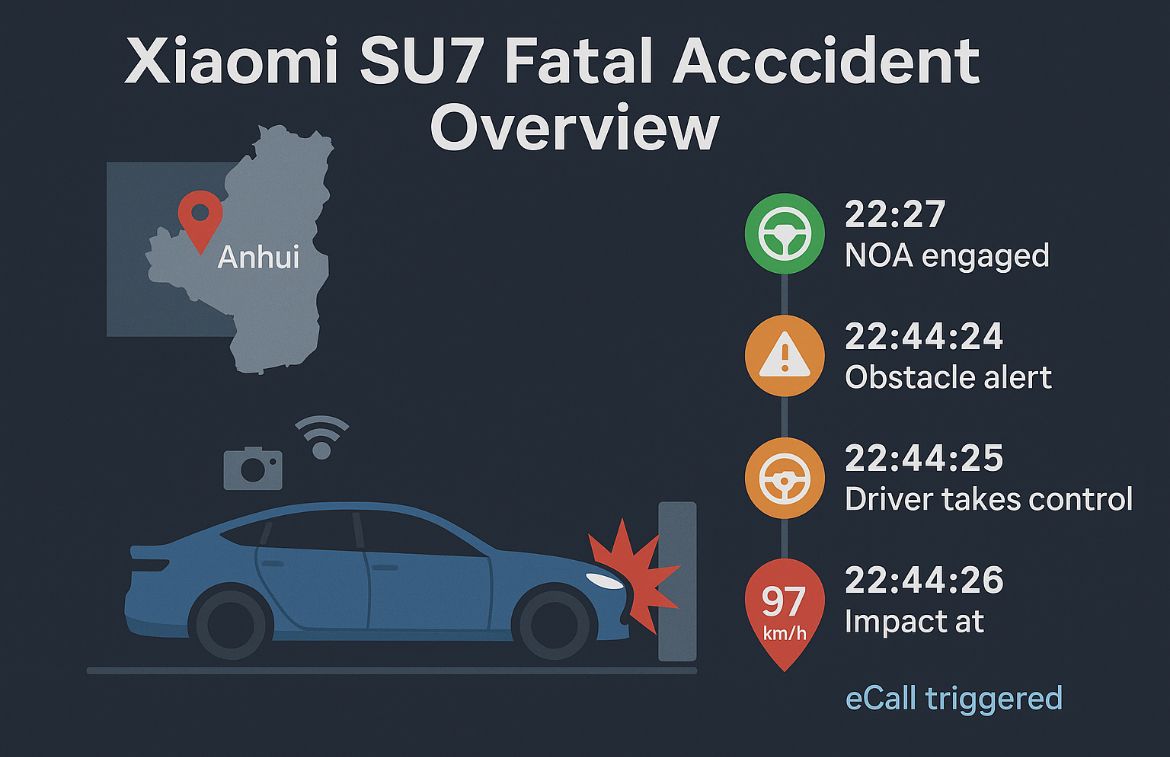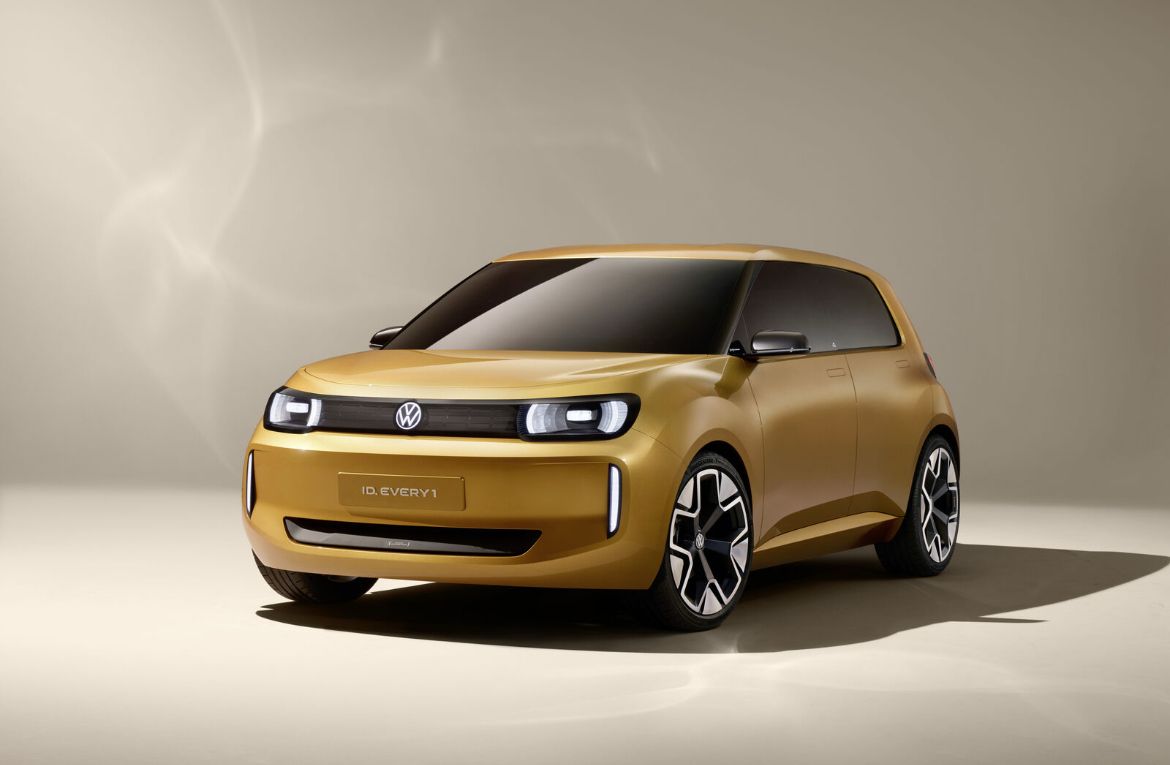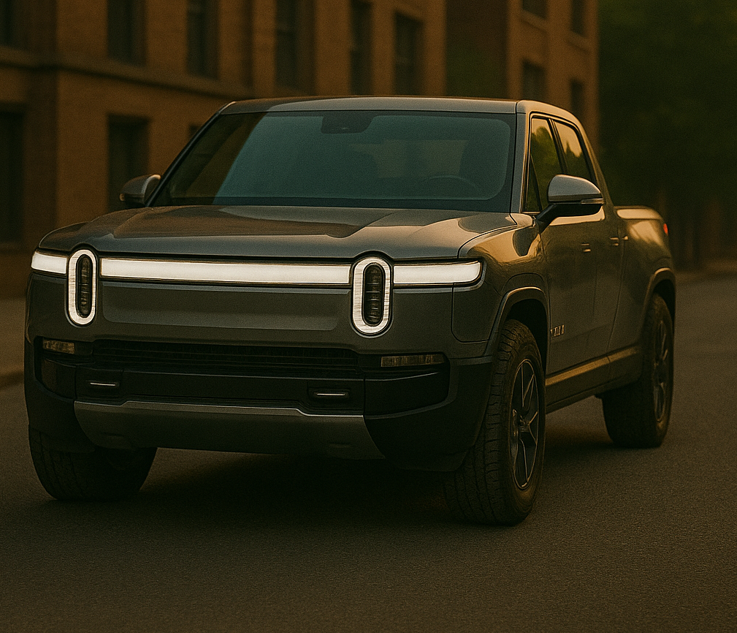Your cart is currently empty!
The Xiaomi SU7 Highway Crash: What Happened, Why It Matters, and What Comes Next?
Posted by:
|
On:
|

1 Accident Overview
On 29 March 2025, a base-trim Xiaomi SU7 travelling on the Dezhou–Shangrao Expressway in Anhui, China, struck a roadside concrete barrier while Navigate on Autopilot (NOA) was active. System logs show the car was cruising at 116 km h-1 when the NOA issued an obstacle alert; the driver grabbed the wheel one second later, but the sedan still hit the barrier at ≈97 km h-1, burst into flames, and all three occupants were killed [1]. Xiaomi told police it is co-operating fully and has already supplied raw driving data for download [2].
2 Crash Timeline and Key Telemetry
| Local time (hh:mm:ss) | Event | Vehicle state |
| 22 : 27 : 17 | NOA engaged | 116 km h-1 |
| 22 : 28 : 17 | Mild-distraction warning | — |
| 22 : 36 : 48 | “Hands on wheel” alert | — |
| 22 : 44 : 24 | Obstacle ahead alert | Brake request |
| 22 : 44 : 25 | Driver takes control | Wheel ≈ 22° L, brake 31 % |
| 22 : 44 : 26 | Impact with barrier | 97 km h-1 |
| 22 : 44 : 28 | eCall triggered | — |
| (The sequence is reconstructed from Xiaomi’s own event log [3] and highway-patrol data [1]). |
The human had ≈0.8 s from alert to impact—far below the 2.3 s average NHTSA reaction benchmark. AEB logic slowed the car ~19 km h-1 but did not fully stop because the software treats rigid, stationary objects differently from moving lead vehicles [1].
3 Technical Factors
- Sensor suite (base SU7) — 11 cameras, 3 mm-wave radars, 12 ultrasonics; no LiDAR [6].
- Compute — Single NVIDIA DRIVE Orin-X SoC (254 TOPS) running Xiaomi Pilot (L2+) software.
- Battery — 73.6 kWh BYD FinDreams LFP “blade” pack (400 V) [8].
- Brakes & chassis — Brembo four-piston front calipers, Bosch ABS/ESC, ZF dampers [9] , [10] .
Why did AEB not save the car? Xiaomi’s driver-assist logic prioritises moving obstacles; at highway speeds the camera–radar fusion often filters out static objects to avoid false positives. With only vision and radar, the barrier’s geometry may have been mis-classified until it filled the field of view, leaving too little braking distance [13].
4 Camera-Only vs LiDAR Debate
Higher SU7 trims (Pro/Max) add a roof-mounted Hesai AT128 LiDAR and a second Orin for 508 TOPS of compute [7]. LiDAR gives centimetre-grade range and detects low-contrast obstacles—even at night or in glare—that cameras struggle with. Tesla’s all-camera Autopilot faces similar scrutiny: the U.S. NHTSA is probing 2.4 million Teslas after multiple stationary-object crashes [11], while a 2023 recall addressed Autopilot misuse when hitting parked emergency vehicles [12]. Critics argue the Xiaomi accident shows why redundant sensing remains prudent until full-stack vision AI matures [13].
5 Global Safety & Validation Standards
- China—after the crash, MIIT banned terms like “smart” or “autonomous driving” in ads and now requires type-approval for over-the-air (OTA) driving-software updates [17].
- United States—NHTSA is adding four ADAS test items to NCAP and is openly investigating Tesla FSD performance in low-visibility scenarios [15], [11].
- European Union—Euro NCAP’s 2024 protocol roughly doubles the number of assisted-driving scenarios and emphasises stationary-object AEB performance [14].
These tighter test matrices contrast with China’s rapid “release-first, refine-later” cycle, where new entrants like Xiaomi shipped the SU7 in barely two years.
6 Market Fallout
Within two weeks of the crash, new SU7 orders fell ≈55 % month-on-month as refunds and social-media backlash mounted [4]. Analysts fear the incident could slow Chinese EV expansion abroad just as the EU weighs tariffs on subsidised imports [18]. Meanwhile, LiDAR suppliers such as Hesai expect the tragedy to accelerate multi-sensor demand and are already planning cheaper next-gen units to reach mass-market price points [7].

7 How the SU7 Compares
| Metric | Xiaomi SU7 (base) | Tesla Model 3 (2025) | NIO ET5 | EU Benchmark (Euro NCAP ‘24) |
| Sensors | Camera + radar | Camera only | Camera + LiDAR + radar | Camera + LiDAR + radar (test spec) |
| AEB stationary target (110 km h-1) | Partial stop (software-limited) | Often no braking | Full stop | Must stop to score “Very Good” |
| Development cycle | ≈24 mo | ≈18 mo refresh | ≈36 mo | 48 – 60 mo typical |
| Recent fatal ADAS crash? | Yes (2025) | Yes (2023, 2024) | Yes (2021) | — |
8 Take-Aways for Engineers & Enthusiasts
- Redundancy matters—A single perception modality can miss edge-cases. Multi-sensor stacks cost more but mitigate blind-spots.
- Human factors remain critical—Even the quickest alerts are futile without enough reaction time; driver-monitoring must escalate earlier.
- Validation is no longer optional—Euro NCAP’s 40 new tests and MIIT’s OTA-approval rule show regulators aligning safety with software pace.
- Market perception can swing overnight—A single high-profile crash cut SU7 demand in half and sparked nationwide ad-language reform.
9 Conclusion
The March 29 Xiaomi SU7 tragedy is a stark reminder that today’s Level-2 “pilot” features are assistance, not autonomy. Vision-heavy systems can work brilliantly in most conditions, but the physics of a 2-tonne sedan give drivers and algorithms mere fractions of a second to react when things go wrong. As China tightens oversight and Europe and the U.S. expand ADAS testing, EV makers—new and established—must balance speed-to-market with exhaustive safety validation. Until then, the smartest car on the road is still the one with an alert human behind the wheel.
References
[1] CarNewsChina, “First fatal accident involving Xiaomi SU7 claims three lives,” 1 Apr 2025.
[2] Reuters, “China’s Xiaomi says it is cooperating with police after fatal EV accident,” 1 Apr 2025.
[3] 36氪 (36kr), “Behind the Xiaomi car accident: intelligent driving under scrutiny,” 2 Apr 2025.
[4] Reuters, “Xiaomi’s new EV orders slump in China as consumer backlash grows,” 14 May 2025.
[5] Reuters, “China bans ‘smart’ and ‘autonomous’ driving terms from vehicle ads,” 17 Apr 2025.
[6] “Xiaomi SU7,” Wikipedia, accessed 19 May 2025.
[7] Hesai Technology, “Xiaomi Unveils Revolutionary SU7… Equipped with AT128 LiDAR,” press release, 2 Apr 2024.
[8] CNEVPost, “Xiaomi SU7 standard gets random CATL/BYD batteries,” 27 May 2024.
[9] SMBOM.com, “Who are the key suppliers for Xiaomi SU7?” Jan 2025.
[10] Brembo, “Precision and power for the Xiaomi SU7 Max,” product page, Apr 2025.
[11] Reuters, “US probes Tesla’s Full Self-Driving software in 2.4 million cars,” 18 Oct 2024.
[12] Reuters, “Tesla recalls over 2 million vehicles after Autopilot crashes into emergency vehicles,” 13 Dec 2023.
[13] Fast Company, “Why Tesla’s camera-only approach may be a mistake,” 19 Mar 2025.
[14] AB Dynamics, “What the 2024 update to Euro NCAP’s assisted-driving grading means,” 2024.
[15] NHTSA, “NCAP Final Decision Notice—ADAS Roadmap,” Nov 2024.
[16] CarNewsChina, “Xiaomi SU7 scores five stars in C-NCAP crash test,” 25 Mar 2025.
[17] Gizmodo, “China bans ‘autonomous driving’ claims from car marketing following crash,” 17 Apr 2025.
[18] Focus (CBBC), “China’s autonomous-driving crackdown: global implications,” 24 Apr 2025.
Posted by




